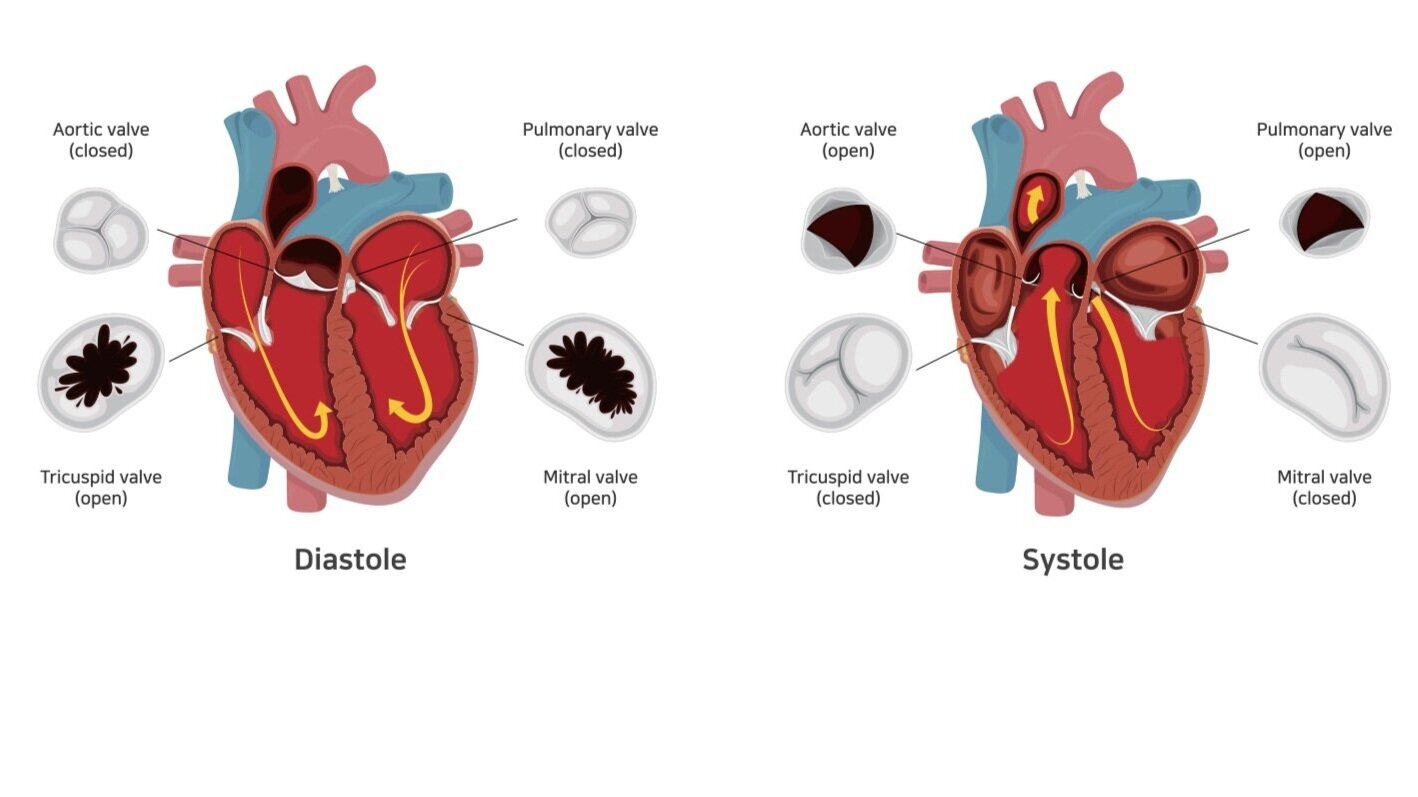Heart murmurs are common in dogs. We hear them every day, but if we hear one in your dog, should you be worried?
Let’s take a look at what a murmur is and what you need to know.
What is a heart murmur?
A heart murmur is a type of abnormal sound that can be detected when listening to the heart with a stethoscope (a procedure called auscultation).
Normally, we hear two distinct sounds. Medically these are called S1 and S2 but most of us know them as lub and dub. Listening to a normal heart beating sounds like lub-dub … lub-dub … lub-dub.
The lub sound represents the closing of the top two valves (the mitral and tricuspid) and the dub sound represents the closing of the bottom valves (aortic and pulmonary). See below
A murmur is an extra sound, often heard between the lub and the dub. So we hear lub-whoosh-dub … lub-whoosh-dub … lub-whoosh-dub. Some murmurs are loud enough to drown out the other heart sounds so we only hear whoosh … whoosh … whoosh.
The murmur sound comes from turbulent blood flow. Before we look at the causes of turbulence, we need a quick refresher of heart anatomy and function.
This is a diagram of a human heart but it’s pretty much the same in dogs.
anatomy of the heart
The heart has four chambers:
right atrium
right ventricle
left atrium
left ventricle
The atria are smaller and at the ‘top’ of the heart. The ventricles are larger and at the ‘bottom’ of the heart.
There are also four valves in the heart:
tricuspid valve (between the right atrium and the right ventricle)
pulmonary valve (between the right ventricle and the pulmonary artery)
mitral valve (between the left atrium and left ventricle)
aortic valve (between the left ventricle and the aorta)
There’s obviously a lot more to it (including all the electrical parts and sensors etc) but that’s all we really need to know for murmurs.
FUNCTION OF THE HEART
If we follow the blood through the heart (via the arrows in the diagram above and below), we get an idea of function.
Blood from the body enters the right atrium. It passes through the tricuspid valve into the right ventricle. The right ventricle fills up as the heart muscle is relaxed (in diastole) and the pulmonary valve is closed. When the right ventricle contracts (systole), the tricuspid valve closes and the pulmonary valve opens, pumping the blood from the heart through the pulmonary valve into the lungs.
In the lungs, the blood becomes oxygenated and gives off carbon dioxide.
From the lungs, the blood then enters the left atrium. It passes through the mitral valve into the left ventricle. The left ventricle fills up as the heart muscle is relaxed and the aortic valve is closed. As the left ventricle contracts, the mitral valve closes and the aortic valve opens. The blood is then pumped through the aortic valve into the aorta and around the body.
The valves act like gates, letting the chambers fill and preventing blood from flowing backward.
Diastole is when the heart is relaxed and filling. Systole is when the heart is contracting and pushing blood out.
What causes a heart murmur?
The most common cause of a heart murmur (ie turbulent blood flow in the heart) is a valve problem. We have two main types of problem:
a leaky valve – that allows backflow through it when it’s closed
a stiff valve – that doesn’t open up properly and blood has to ‘squeeze’ through it
Other causes of turbulence include:
a ‘hole in the heart’ (eg a patent ductus arteriosus, ventral septal defect)
a narrowing of a chamber (eg when the heart muscle thickens due to hyperthyroid disease in cats)
anaemia (ie too few red cells in the blood)
a very rapid heart rate (and breathing rate) in an excited or anxious dog
All of these cause the blood to ‘churn’ rather than flow and we then hear a murmur – but note that not all of them are caused by heart disease. There’s nothing wrong with the heart in the bottom two examples.
We can get clues to the cause of a murmur from the dog’s age and breed and from where the murmur is the loudest, when it occurs (ie during systole or diastole) and how it sounds. For example, a murmur due to a patent ductus arteriosus is heard continuously in the left armpit and sounds like a sneaker in a washing machine.
By far, the most common cause of a murmur in dogs is a leaky mitral valve. These are the whooshy murmurs, loudest on the lower left side of the chest (and usually in older dogs).
What does the grade of the murmur mean?
If your dog has been diagnosed with a heart murmur, you’ve probably been told that it’s a certain grade (1 to 6).
This simply refers to how loud the murmur is – it doesn’t always relate to the severity of the disease causing the murmur.
A grade 1 murmur is very soft and can only be heard in a quiet room with careful listening. A grade 6 murmur is so loud that you really don’t need a stethoscope, you can hear/feel the vibrations through the chest. Note that these grades are subjective – what sounds like a 2 to one person may sound like a 3 to another.
How is the cause of the murmur diagnosed?
As mentioned, in many cases, looking at the dog and listening to the murmur tells us the most likely cause.
If we’re unsure of the cause or we need to work out if the murmur is problematic, we may need to do some testing. Depending on the situation, this could involve:
a heart ultrasound (called an echocardiogram or echo) – this allows for evaluation of the valves and the chambers of the heart (we can do very basic echoes inhouse but refer to a specialist cardiologist for comprehensive scans)
chest X-rays – these allow us to see the size and shape of the heart and assess the lungs (but we can’t see the valves)
blood tests – these can help us look for other conditions that can affect the heart (eg anaemia, thyroid disease) and we can check for special factors that tell us if the heart is stretched
Not all heart murmurs require investigation.
What is the treatment for a heart murmur?
When treatment is indicated, it’s aimed at:
the underlying disease (eg surgery to open up a stiff valve)
the consequence of heart disease (eg diuretics for congestive heart failure)
The most common underlying cause (leaky mitral valve) does not have any curative treatment as valve replacement surgery is not really available for dogs as yet.



